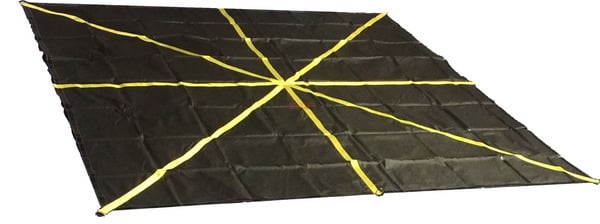It used to be said that having to remove construction debris was a problem that was never adequately solved. Dumpsters were no doubt a workable solution, but they involve a lot of time, labor, and expense. Yet that is all people had access to until the invention of the demolition tarp.
Fans of demolition tarps say these are superior to dumpsters in a lot of different ways. We don’t know if that’s true, but we can say that demo tarps certainly have their place in the arena of construction and debris removal. They are effective, easy to deploy, and usually do not require permits.

Having said that, there are certain dangers associated with demolition tarps. A safety-first mindset demands that they be used in ways that minimize risks and protect workers. We recommend using demolition tarps with the same care and precision planning that goes into rigging and lifting. Below are a few tips for doing so.
Webbing Always Down
Demolition tarps are constructed with a combination of vinyl tarp material and a number of webbing straps. The straps perform the same function as the legs of a rigging sling: they provide underlying support for the material being lifted as well as providing the actual lifting points.
We say all that to say this: a demolition tarp should always be laid out with the webbing facing the ground. If you lay it out with the webbing face up, you lose the support of the straps during the lift. Material can break through an unsupported tarp or even cause the tarp itself to break loose from the webbing.
Never Overload
A demolition tarp only has a limited capacity. It should be marked on the tarp itself. If a tarp is brand-new and still in its packaging, its maximum weight capacity should be printed on the outside of the package as well. Pay attention to this number so that you do not overload the tarp.
Overloading a demolition tarp creates a dangerous situation that could be potentially harmful. Too much weight could split the tarp material, break one of the webbing straps, or even cause problems for the crane operator. Under no circumstances should you ever overload a demolition tarp, even by a few pounds.
Monitor Construction Debris
Next, monitor the construction debris that ends up being tossed into a demo tarp. Anything with sharp edges should either be blunted or disposed of in another way. As tough as demo tarps are, they are not completely immune from rips and tears. A piece of waste with a sharp edge could cut the tarp on lift, causing the entire thing to break open. Not only will you have a mess to clean up, but you will also have a demo tarp that cannot be used again.
Keep Clear
Just as would be the case loading cargo on the back of a flatbed trailer, lifting a full demolition tarp should never begin until the area is cleared. Anyone present at the time of the lift should be well away from the danger zone – just in case something goes wrong. You can never be too cautious by requiring workers to keep a distance of 20 feet or more.
Inspects Tarps Regularly
Finally, if you deploy reusable demo tarps, make sure to inspect them regularly. An inspection prior to each use reduces the risks of you accidentally deploying a tarp starting to show excessive wear. And if you do find one that’s showing wear, don’t take a chance. Demo tarps are cheap enough that it is worth replacing them at the first signs.










